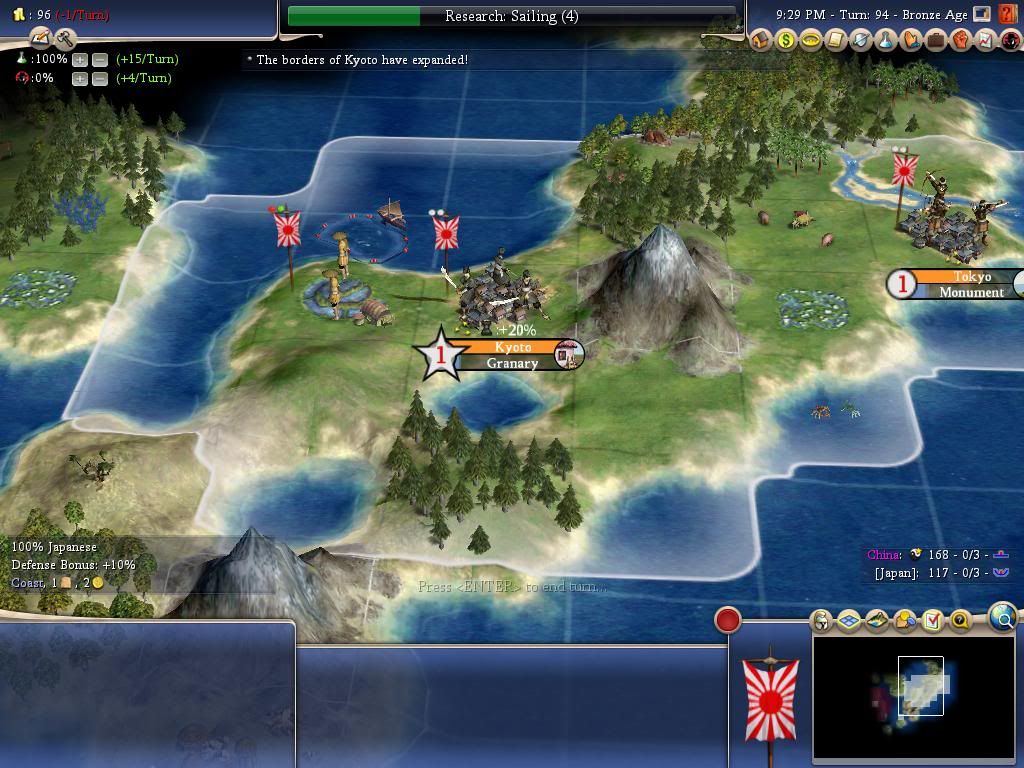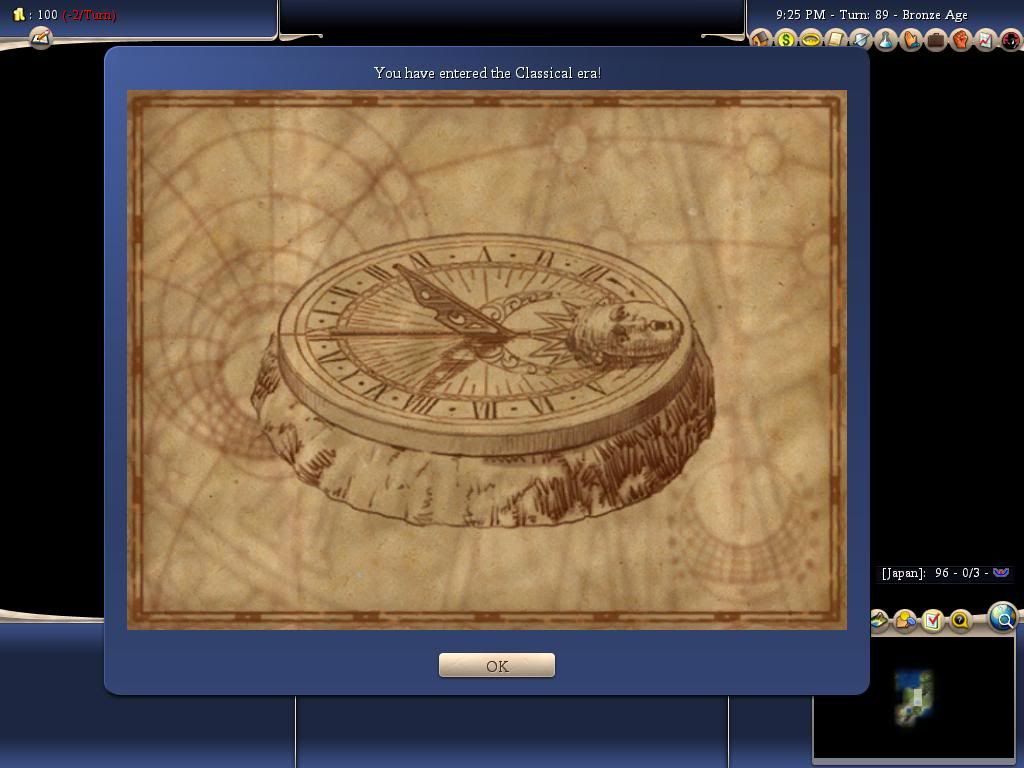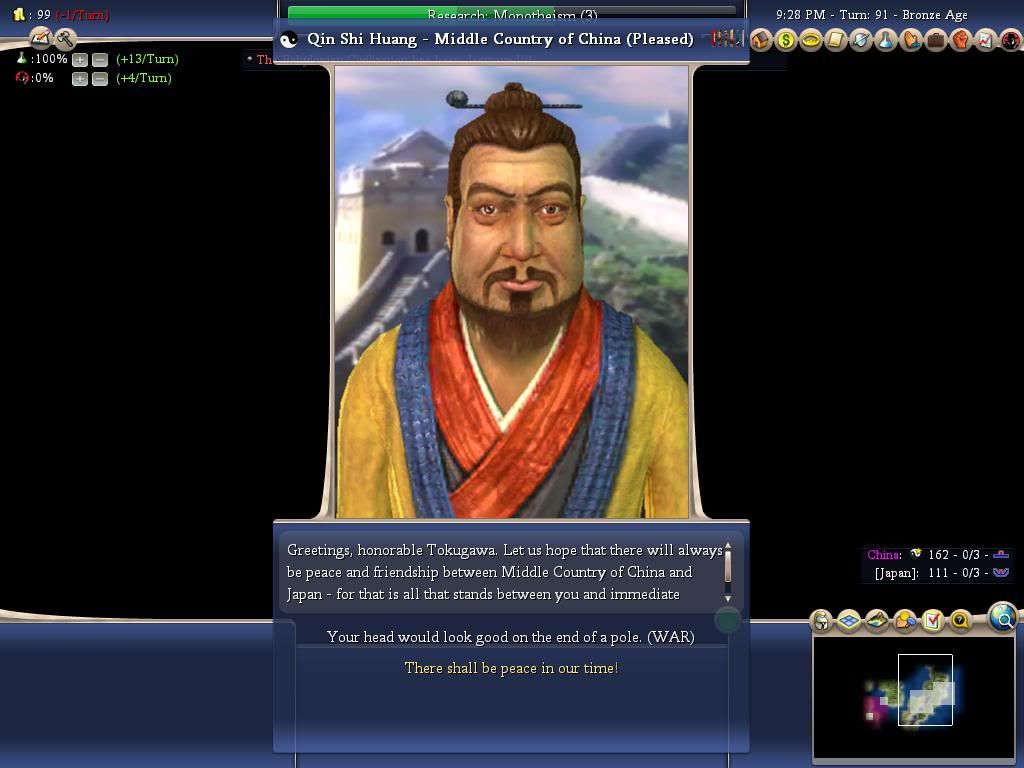Upstart: The Beginning of the Japanese Civilization
Dawn breaks upon the Japanese people
they have come from places whose names have been lost to the wind, they are in tribes and clans that distrust one another to the extreme, and they are a shaken people
they know almost nothing of the outside world beyond the home island of Honshu, but they have determination, courage, persistency, and a thirst for honor and glory that cant be measured in mere words, but by the actions that they do.

The Japanese people are few, but their determination is already seeing them through on the island of Honshu. Already, their great capital of Kyoto has been settled to the western edge of the island, and their fellow Japanese people have already planned and moved to another location, this one on the eastern edge of the great home island. On the coast, fish are in plentiful supply and in the hills wild pigs and boars can be found and seen, as well as the wild rice that grows in abundance to the southeast of their current position
all in all, they believe that this is a good spot.


The waters and waves of the ocean that lash against the shore are a cruel mistress
Mt. Fuji rises in the background behind their newly planned city, as they see the great and might Taihei You lash against the shores of the eastern edges of the Japanese home island. This ocean is mighty, a cold mistress though that brings about tsunamis and the divine wind of monsoons, when they do not snake around the southern tip of the island to slam into the western edge of Honshu.
Despite the hardships that the Japanese people have faced before (bear attacks, wolf attacks, fox attacks, monsoon attacks, tree attacks, heart attacks, wave attacks, boats collapsing in the water
) they have managed to pull through as a somewhat unified and cohesive people that are willing to work together in order to see their fair nation rise to greatness in the world
no matter the cost that it may be.
Despite what many would say about the early roots of the Japanese people, their settlement of the home island was a lengthy and arduous affair. They need material to build houses and buildings, needed guards to keep the cities safe and the citizens happy, which required more building material to build housing for these troops. Not only that, but the workers involved on many of these projects suffered from lack of food, overexertion, heat exhaustion, and much, much more. Boats also needed to be constructed to start pulling the harvests of the sea (namely fish and crabs) so that the Japanese people could be fed a healthy diet. They also needed places to store dried food and what not and needed cohesive leadership in order to hold and bind the nation together.
The first emperor of Japan was a rather diminutive man, one that many people would not have expected to ascend to the throne of emperor. Even so, Emperor Suzaku was a clever and cunning man. He managed to get the clan chiefs from all across Japan to declare him to be the Emperor of Japan, and its protector, claiming descent from the legendary Japanese sun god Amaterasu as well. By getting all of the other clan chiefs to declare for him, and offering incentives for those that did, Suzaku built himself a strong power base among the Japanese elite, from which he controlled most of them, and the entire country itself to boot. Suzakus sharp mind also allowed him to make sure that none of the clans could rise against him, something that would be rather overruled later on in history, when clans would rise up against the Emperor, citing him as not being the true Emperor
later Emperors that is, not Suzaku himself.
As for the clans themselves, they were a mixed bag. None were good or evil, but instead chose the grey path of morality, like most real life people do instead of a clearly malevolent or paragon path through life, like so many people would have modern sources to believe. The Hata clan, descended from the Chinese emperor Qin Shi Huang and migrants to Japan. The Soga clan, an intellectual and spiritual clan that was one of the most powerful during its time in Japan. The Abe clan, an ancient Japanese clan and a major one to boot and who were quite powerful given their circumstances. And many more clans, both large and small that are too numerous to even list in this section of history, as more would rise and fall with every Emperor that ascended to the throne of the Japanese Empire.
Anyways
where were we? Ah yes, Japan and its struggle to become a powerful nation on the home island of Honshu
Both cities of Kyoto and Tokyo were raised by the end of the first thirty five years of the Emperors ascension to power upon the throne of Japan
in that time, plenty had happened. The valuable fish hanging around the Kyoto coastline were on the dinner menu to be harvested by the hungry fishermen and workers along Kyotos harbors and whatnot. At the same time, the aging Emperor had bid a group of sailors to take a lightly armed, fast clipper boat to explore the world and report back to Japan every five years or so to tell the Emperor of their findings. Suzaku watched them go and died in peace the very next day, with his son succeeding him on the throne for the Japanese Empire.
The explorations of this tiny little vessel took it to distant locations to the west of Japan. First, they found the tiny Korean civilization thriving to a certain extent, but not very much so. The Koreans had a highly rural society and not many cities by this point in history, but they had an excuse for that. Barbarians often raided into the Korean peninsula, and often made off with plenty of loot and women and slaves while burning everything to the ground behind them. All in all, it was a miserable life in Korea, as the farmers and the craft workers that lived there could not do very much, given their circumstances and lack of weapons. Many of them were forced to pay tribute to these Manchu barbarians that raided into their peninsula, and even then they were not guaranteed not to be horribly torn apart and mutilated
if they were lucky. Back then, it was trying times for civilization in Eastern Asia, and the majority of barbarians that were Manchus did not help. Contrary to popular belief though, not all barbarians were Manchu, and not all Manchu people were barbarians.
Anyways
the tiny little clipper made its way further to the west of Japan, to explore the coastline to the East. It was said that a powerful people lived over there, and the Hata clan was very secretive about that. It was said back in those times that the Hata clan migrants were descended from these people on the mainland, and it was later found out to be true indeed.
It was during the seventh year of their voyage that the tiny clipper finally found its way off of the coast of China, and a massive Chinese city (at least compared to the cities of Kyoto and Tokyo back home).
The Chinese were very accommodating of the Japanese crew, and hosted them there in the capital city of Shanghai for several days. In those days, the Chinese dynasty of the Zhou was in power, the Shang haven fallen nearly a thousand years earlier to the Zhou. China had been united under the rule of these Zhou kings, at least part of it has, with feudal lords and rulers taking control of small parcels of land under the direction of the Zhou. This system is somewhat mirrored in Japan itself, with the local lords, or daimyos, ruling large areas of Japan under orders from the Emperor himself, with large amounts of taxes fueling the coffers of the Japanese government.
While they are there, the sailors learn plenty about Chinese culture and legends and writing, the fine calligraphy style of drawing-writing that in time will be taken, evolved, and adapted to suit the needs of the Japanese people back on the island of Honshu. The Zhou king of China also sends diplomats and ambassadors to the Japanese, in order to foster good relations between the two nations. Not only that, but small amounts of trade have been opened up between these two nations, though not in full as of yet. Both the Zhou and the Emperor of Japan seem content to leave the borders closed to each other at the moment, at least until both civilizations get to know each other better. This will come in time, as trust is built on foundations of peace and trade, as it is commonly said, and so far there has not been enough of that to warrant trust on either side. Eventually though, the borders will open, almost everyone is certain of it.

Archers that have mobilized from the available garrison at Kyoto are making their way to Tokyo to attempt to keep the city under guard and protect it with all of their might. Though Tokyo is just a tiny bit smaller than the city of Kyoto, it is a valuable city that cant be allowed to go unprotected
it is feared that one day, barbarians from the north and from the northwest will finally achieve sailing technology and stream over the mountains to occupy Japan, and possibly burn large swathes of it to the ground. Tales of what has been witnessed in Korea, with its burned down towns and villages of all shapes and sizes, and the people that must pay tribute to barbarian overlords in the hope that they are not butchered in the night when the overlords come to call for some sport and fun, have already reached the ears of the Japanese people, and the mild case of xenophobia that had been fostered for a while in the hearts and minds of a large amount of Japanese people is being realized fully.
At the same time, word is spreading from the far west
that an ancient civilization known as Babylonia has been destroyed from the outside and internal pressures that have exerted on it. The name Babylon and Chaldea is unknown to the Japanese people at the time, but the loss of a civilization in the world is both good tidings and bad
for it means that whoever has done that just might come for the people of Japan as well. Most Japanese brush it off, but the Emperor opens up more talks with the Chinese Zhou king, in order to keep up to date information on what goes on to the west of Japan.
On the western coast of Honshu, many people are enjoying this new delicacy of fine fish that are brought forth on tugs and boats from the waters to the markets and stalls of Kyoto, and are slowly being transported by land and small ship to Tokyo. These fine fish are many and are quite delicious, their names rolling off the tongues of the people like the pieces of the creatures roll the opposite direction. The Taihei You Codfish that are quite a delicacy, the Nekogigi, and also a species of puffer fish that are quite fine to eat, albeit rather poisonous and a danger for those faint of heart
and of the antidote.



A monument to the First Emperor Suzaku is beginning its construction in the city of Tokyo. Since Suzaku was the ruler of the city before becoming Emperor, he enjoys some nice legendary status there as a fine leader and a model for Japanese citizenry everywhere. Suzakus monument is being built entirely out of limestone quarried in small amounts by the local people, as all pitch in to help in this construction effort.
At the same time, workers from many areas across Japan are creating farms and roads to feed the populace of the nation. This practice of peasants led by overseers in order to construct farms, villages, and other public works, is happening all across the tiny Japanese nation, from the small towns to the cities, and the major metropoliss of Japan.
 . To be specific, this is another narrative, with a slower pace, that will take tertiary importance, meaning that Hammer and Steel will almost always come first unless I am developing the next chapter, than Rome, then Honor and Glory. This may change from time to time though, when Rome becomes rather boring for me, or I need a break from writing it. Hammer and Steel is not abandoned of course, as after pouring that much time into the thread, I'm not leaving it to wither and die. Instead, I am hoping to get this story out, and give a more streamlined, linear, and nice narrative, rather than the hopping narrative of Hammer and Steel that I am sure has driven away some people.
. To be specific, this is another narrative, with a slower pace, that will take tertiary importance, meaning that Hammer and Steel will almost always come first unless I am developing the next chapter, than Rome, then Honor and Glory. This may change from time to time though, when Rome becomes rather boring for me, or I need a break from writing it. Hammer and Steel is not abandoned of course, as after pouring that much time into the thread, I'm not leaving it to wither and die. Instead, I am hoping to get this story out, and give a more streamlined, linear, and nice narrative, rather than the hopping narrative of Hammer and Steel that I am sure has driven away some people.

 . To be specific, this is another narrative, with a slower pace, that will take tertiary importance, meaning that Hammer and Steel will almost always come first unless I am developing the next chapter, than Rome, then Honor and Glory. This may change from time to time though, when Rome becomes rather boring for me, or I need a break from writing it. Hammer and Steel is not abandoned of course, as after pouring that much time into the thread, I'm not leaving it to wither and die. Instead, I am hoping to get this story out, and give a more streamlined, linear, and nice narrative, rather than the hopping narrative of Hammer and Steel that I am sure has driven away some people.
. To be specific, this is another narrative, with a slower pace, that will take tertiary importance, meaning that Hammer and Steel will almost always come first unless I am developing the next chapter, than Rome, then Honor and Glory. This may change from time to time though, when Rome becomes rather boring for me, or I need a break from writing it. Hammer and Steel is not abandoned of course, as after pouring that much time into the thread, I'm not leaving it to wither and die. Instead, I am hoping to get this story out, and give a more streamlined, linear, and nice narrative, rather than the hopping narrative of Hammer and Steel that I am sure has driven away some people.



















